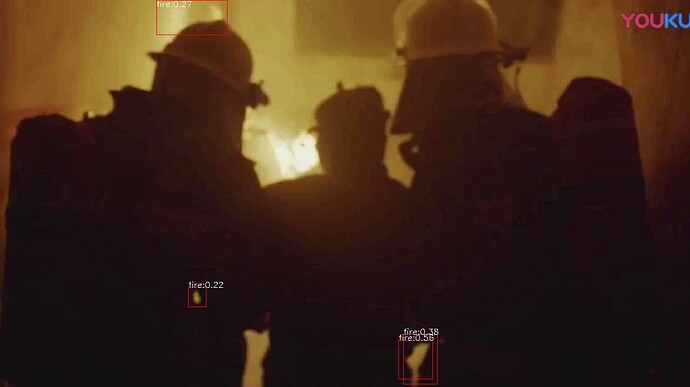原图
nvidia NX + darknet
VIM3+yolov3_88nb
我的 转换脚本
#!/bin/bash
#NAME=mobilenet_tf
NAME=yolov3
ACUITY_PATH=../bin/
convert_caffe=${ACUITY_PATH}convertcaffe
convert_tf=${ACUITY_PATH}convertensorflow
convert_tflite=${ACUITY_PATH}convertflit
convert_darknet=${ACUITY_PATH}convertdarknet
convert_onnx=${ACUITY_PATH}convertonnx
convert_keras=${ACUITY_PATH}convertkeras
convert_pytorch=${ACUITY_PATH}convertpytorch
#$convert_tf \
# --tf-pb ./model/mobilenet_v1.pb \
# --inputs input \
# --input-size-list '224,224,3' \
# --outputs MobilenetV1/Predictions/Softmax \
# --net-output ${NAME}.json \
# --data-output ${NAME}.data
#$convert_caffe \
# --caffe-model xx.prototxt \
# --caffe-blobs xx.caffemodel \
# --net-output ${NAME}.json \
# --data-output ${NAME}.data
#$convert_tflite \
# --tflite-mode xxxx.tflite \
# --net-output ${NAME}.json \
# --data-output ${NAME}.data
$convert_darknet \
--net-input model/chaofeng.cfg \
--weight-input model/chaofeng.weights \
--net-output ${NAME}.json \
--data-output ${NAME}.data
#$convert_onnx \
# --onnx-model xxx.onnx \
# --net-output ${NAME}.json \
# --data-output ${NAME}.data
#$convert_keras \
# --keras-model xxx.hdf5 \
# --net-output ${NAME}.json --data-output ${NAME}.data
#$convert_pytorch --pytorch-model xxxx.pt \
# --net-output ${NAME}.json \
# --data-output ${NAME}.data \
# --input-size-list '1,480,854'
#!/bin/bash
#NAME=mobilenet_tf
NAME=yolov3
ACUITY_PATH=../bin/
tensorzone=${ACUITY_PATH}tensorzonex
$tensorzone \
--action quantization \
--dtype float32 \
--source text \
--source-file data/validation_tf.txt \
--channel-mean-value '0 0 0 256' \
--reorder-channel '2 1 0' \
--model-input ${NAME}.json \
--model-data ${NAME}.data \
--quantized-dtype dynamic_fixed_point-i8 \
--quantized-rebuild \
# --batch-size 2 \
# --epochs 5
#Note:
# 1.--quantized-dtype asymmetric_affine-u8 , you can set dynamic_fixed_point-i8 asymmetric_affine-u8 dynamic_fixed_point-i16(s905d3 not support point-i16) perchannel_symmetric_affine-i8(only for t965d4/t982ar301)
# 2.default batch-size(100),epochs(1) ,the numbers of pictures in data/validation_tf.txt must equal to batch-size*epochs,if you set the epochs >1
# 3.Other parameters settings, Refer to sectoin 3.4(Step 2) of the <Model_Transcoding and Running User Guide_V0.8> documdent
#!/bin/bash
#NAME=mobilenet_tf
NAME=yolov3
ACUITY_PATH=../bin/
export_ovxlib=${ACUITY_PATH}ovxgenerator
$export_ovxlib \
--model-input ${NAME}.json \
--data-input ${NAME}.data \
--model-quantize ${NAME}.quantize \
--reorder-channel '2 1 0' \
--channel-mean-value '0 0 0 256' \
--export-dtype quantized \
--optimize VIPNANOQI_PID0X88 \
--viv-sdk ${ACUITY_PATH}vcmdtools \
--pack-nbg-unify \
#Note:
# --optimize VIPNANOQI_PID0XB9
# when exporting nbg case for different platforms, the paramsters are different.
# you can set VIPNANOQI_PID0X7D VIPNANOQI_PID0X88 VIPNANOQI_PID0X99
# VIPNANOQI_PID0XA1 VIPNANOQI_PID0XB9 VIPNANOQI_PID0XBE VIPNANOQI_PID0XE8
# Refer to sectoin 3.4(Step 3) of the <Model_Transcoding and Running User Guide_V0.8> documdent
rm -rf nbg_unify_${NAME}
mv ../*_nbg_unify nbg_unify_${NAME}
cd nbg_unify_${NAME}
mv network_binary.nb ${NAME}.nb
cd ..
#save normal case demo export.data
mkdir -p ${NAME}_normal_case_demo
mv *.h *.c .project .cproject *.vcxproj BUILD *.linux *.export.data ${NAME}_normal_case_demo
# delete normal_case demo source
#rm *.h *.c .project .cproject *.vcxproj BUILD *.linux *.export.data
rm *.data *.quantize *.json
还有什么其它需要注意的地方吗?谢谢。


